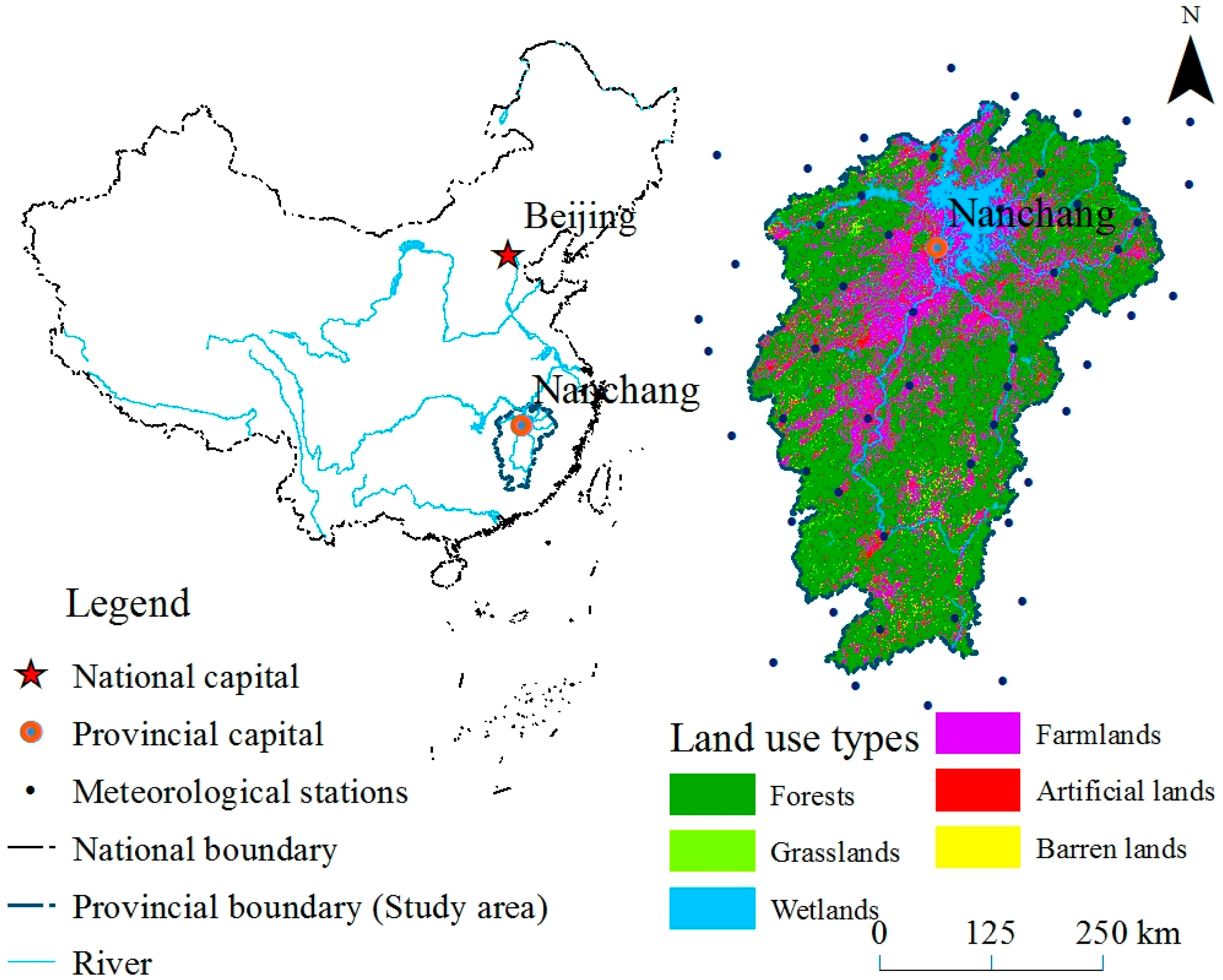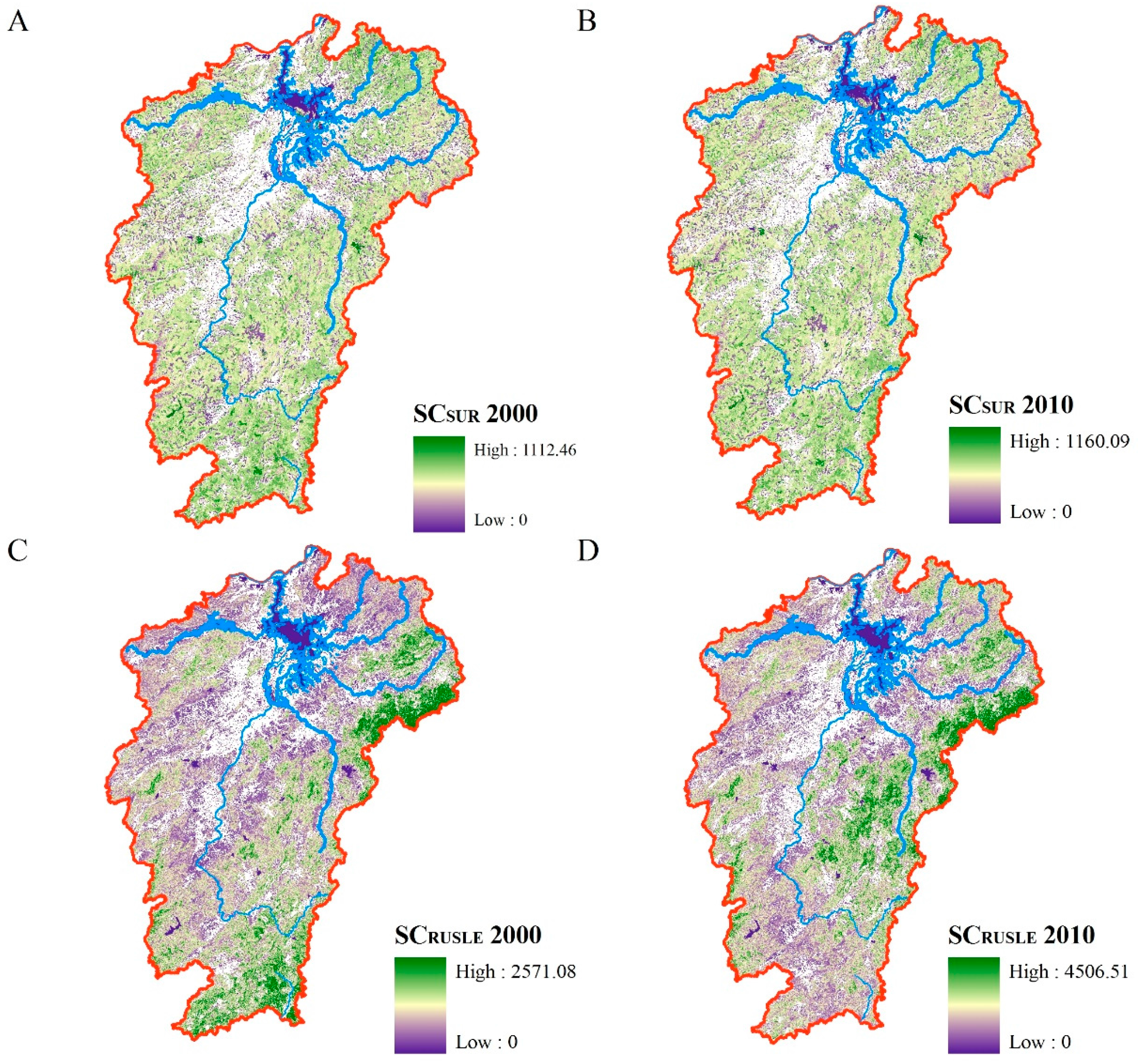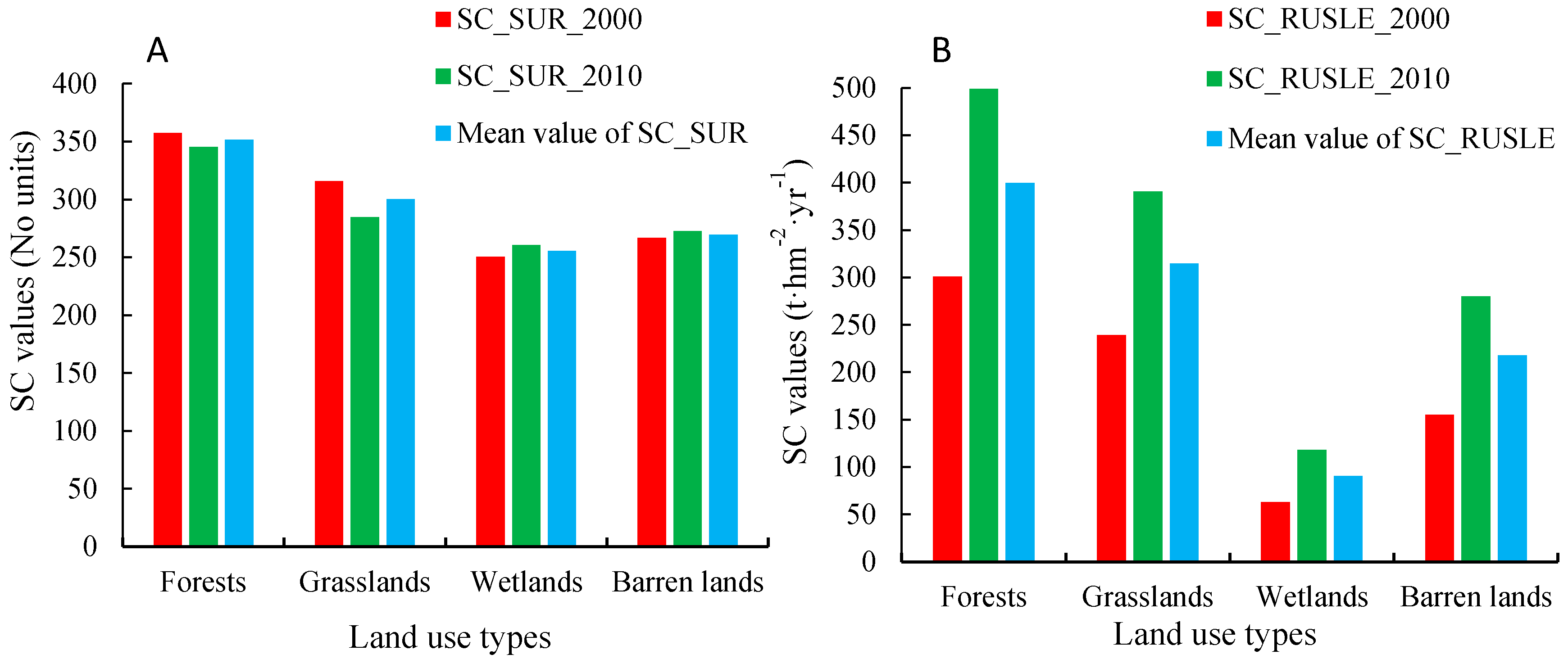Uncertainties of Two Methods in Selecting Priority Areas for Protecting Soil Conservation Service at Regional Scale
Abstract
:1. Introduction
2. Materials and Methods
2.1. Study Area
2.2. Data Sources
2.3. Soil Conservation Mapping Methods
2.3.1. RUSLE-Based Model for Mapping Soil Conservation
2.3.2. The Surrogate Indicator Method for Mapping Soil Conservation Service
3. Results
3.1. Spatial Patterns of SC
3.2. SC Variations under Different Land Use Types, Fractional Vegetation Covers and Land Surface Slopes
3.3. Distance Distributions from Artificial Land, Farmland, and Wetland
4. Discussion
4.1. Characteristics of Using the Two SC Methods in Practice
4.2. Enlightenment after the Comparison of the Two SC Methods
5. Conclusions
Acknowledgments
Author Contributions
Conflicts of Interest
References
- Wilson, K.A.; Underwood, E.C.; Morrison, S.A.; Klausmeyer, K.R.; Murdoch, W.W.; Reyers, B.; Wardell-Johnson, G.; Marquet, P.A.; Rundel, P.W.; McBride, M.F.; et al. Conserving biodiversity efficiently: What to do, where, and when. PLoS Biol. 2007, 5, 12. [Google Scholar] [CrossRef] [PubMed]
- Ferrier, S.; Wintle, B.A. Quantitative approaches to spatial conservation prioritization: Matching the solution to the need. In Spatial Conservation Prioritization: Quantitative Methods & Computational Tools; Moilanen, A., Wilson, K.A., Possingham, H.P., Eds.; Oxford University Press: Oxford, UK, 2009; pp. 1–13. [Google Scholar]
- Lehtomäki, J.; Moilanen, A. Methods and workflow for spatial conservation prioritization using Zonation. Environ. Model. Softw. 2013, 47, 128–137. [Google Scholar] [CrossRef]
- Brooks, T.M.; Mittermeier, R.A.; da Fonseca, G.A.; Gerlach, J.; Hoffmann, M.; Lamoreux, J.F.; Mittermeier, C.G.; Pilgrim, J.D.; Rodrigues, A.S. Global biodiversity conservation priorities. Science 2006, 313, 58–61. [Google Scholar] [CrossRef] [PubMed]
- Paviolo, A.; di Blanco, Y.E.; de Angelo, C.D.; di Bitetti, M.S. Protection affects the abundance and activity patterns of pumas in the Atlantic Forest. J. Mammal. 2009, 90, 926–934. [Google Scholar] [CrossRef]
- Millennium Ecosystem Assessment. Ecosystems and Human Well-Being: Synthesis; World Resources Institute: Washington, DC, USA, 2005. [Google Scholar]
- Egoh, B.; Rouget, M.; Reyers, B.; Knight, A.T.; Cowling, R.M.; van Jaarsveld, A.S.; Welz, A. Integrating ecosystem services into conservation assessments: A review. Ecol. Econ. 2007, 63, 714–721. [Google Scholar] [CrossRef]
- Goldman, R.L.; Tallis, H. A critical analysis of ecosystem services as a tool in conservation projects. Ann. N. Y. Acad. Sci. 2009, 1162, 63–78. [Google Scholar] [CrossRef] [PubMed]
- Polasky, S.; Johnson, K.; Keeler, B.; Kovacs, K.; Nelson, E.; Pennington, D.; Plantinga, A.J.; Withey, J. Are investments to promote biodiversity conservation and ecosystem services aligned? Oxf. Rev. Econ. Policy 2012, 28, 139–163. [Google Scholar] [CrossRef]
- Cowling, R.M.; Egoh, B.; Knight, A.T.; O’Farrell, P.J.; Reyers, B.; Rouget, M.; Roux, D.R.; Welz, A.S. An operational model for mainstreaming ecosystem services for implementation. Proc. Natl. Acad. Sci. USA 2008, 105, 9483–9488. [Google Scholar] [CrossRef] [PubMed]
- Luck, G.W.; Chan, K.M.; Klien, C.J. Identifying spatial priorities for protecting ecosystem services. F1000Research 2012, 1. [Google Scholar] [CrossRef] [PubMed]
- Schulp, C.J.; Alkemade, R. Consequences of Uncertainty in Global-Scale Land Cover Maps for Mapping Ecosystem Functions: An Analysis of Pollination Efficiency. Remote Sens. 2011, 3, 2057–2075. [Google Scholar] [CrossRef] [Green Version]
- Kukkala, A.S.; Moilanen, A. Core concepts of spatial prioritisation in systematic conservation planning. Biol. Rev. 2013, 88, 443–464. [Google Scholar] [CrossRef] [PubMed]
- Daily, G.C.; Matson, P.A. Ecosystem services: From theory to implementation. Proc. Natl. Acad. Sci. USA 2008, 105, 9455–9456. [Google Scholar] [CrossRef] [PubMed]
- Bateman, I.J.; Harwood, A.R.; Mace, G.M.; Watson, R.T.; Abson, D.J.; Andrews, B.; Termansen, M. Bringing ecosystem services into economic decision-making: Land use in the United Kingdom. Science 2013, 341, 45–50. [Google Scholar] [CrossRef] [PubMed]
- Zurlini, G.; Petrosillo, I.; Aretano, R.; Castorini, I.; D’Arpa, S.; De Marco, A.; Pasimeni, M.R.; Semeraro, T.; Zaccarelli, N. Key fundamental aspects for mapping and assessing ecosystem services: Predictability of ecosystem service providers at scales from local to global. Annali di Botanica (Roma) 2014, 4, 53–63. [Google Scholar]
- Xu, W.H.; Xiao, Y.; Zhang, J.J.; Yang, W.; Zhang, L.; Hull, V.; Wang, Z.; Zheng, H.; Liu, J.G.; Polasky, S.; et al. Strengthening protected areas for biodiversity and ecosystem services in china. Proc. Natl. Acad. Sci. USA 2017, 114, 1601. [Google Scholar] [CrossRef] [PubMed]
- De Groot, R.S.; Wilson, M.A.; Boumans, R.M.J. A typology for the classification, description and valuation of ecosystem functions, goods and services. Ecol. Econ. 2002, 41, 393–408. [Google Scholar] [CrossRef]
- Yang, D.; Kanae, S.; Oki, T.; Koike, T.; Musiake, K. Global potential soil erosion with reference to land use and climate changes. Hydrol. Process. 2003, 17, 2913–2928. [Google Scholar] [CrossRef]
- Nelson, E.; Mendoza, G.; Regetz, J.; Polasky, S.; Tallis, H.; Cameron, D.R.; Chan, K.M.A.; Daily, G.C.; Goldstein, J.; Kareiva, P.M.; et al. Modeling multiple ecosystem services, biodiversity conservation, commodity production, and tradeoffs at landscape scales. Front. Ecol. Environ. 2009, 7, 4–11. [Google Scholar] [CrossRef]
- Su, C.H.; Fu, B.J. Evolution of ecosystem services in the Chinese Loess Plateau under climatic and land use changes. Glob. Planet. Chang. 2013, 101, 119–128. [Google Scholar] [CrossRef]
- Guerra, C.A.; Pinto-Correia, T.; Metzger, M.J. Mapping Soil Erosion Prevention Using an Ecosystem Service Modeling Framework for Integrated Land Management and Policy. Ecosystems 2014, 17, 878–889. [Google Scholar] [CrossRef]
- Fu, B.J.; Liu, Y.H.; Lü, Y.H.; He, C.S.; Zeng, Y.; Wu, B.F. Assessing the soil erosion control service of ecosystems change in the Loess Plateau of China. Ecol. Complex 2011, 8, 284–293. [Google Scholar] [CrossRef]
- Andrew, M.E.; Wulder, M.A.; Nelson, T.A.; Coops, N.C. Spatial data, analysis approaches, and information needs for spatial ecosystem service assessments: A review. GIScience Remote Sens. 2015, 52, 344–373. [Google Scholar] [CrossRef]
- Carreño, L.; Frank, F.C.; Viglizzo, E.F. Tradeoffs between economic and ecosystem services in Argentina during 50 years of land-use change. Agric. Ecosyst. Environ. 2012, 154, 68–77. [Google Scholar] [CrossRef]
- Barral, M.P.; Oscar, M.N. Land-use planning based on ecosystem service assessment: A case study in the Southeast Pampas of Argentina. Agric. Ecosyst. Environ. 2012, 154, 34–43. [Google Scholar] [CrossRef]
- Wischmeier, W.H.; Smith, D.D. Predicting rainfall erosion losses: A guide to conservation planning. In Agriculture Handbook No. 537; US Department of Agriculture (USDA): Washington, DC, USA, 1978; pp. 5–8. [Google Scholar]
- Sharpley, A.N.; Williams, J.R. EPIC-erosion/productivity impact calculator: 1. Model documentation. Tech. Bull. U. S. Dep. Agric. 1990, 1, 235. [Google Scholar]
- Sidle, R.C.; Ziegler, A.D.; Negishi, J.N.; Nik, A.R.; Siew, R.; Turkelboom, F. Erosion processes in steep terrain: Truths, myths and uncertainties related to forest management in Southeast Asia. For. Ecol. Manag. 2006, 224, 199–225. [Google Scholar] [CrossRef]
- Lü, Y.H.; Zhang, L.W.; Zeng, Y.; Fu, B.J.; Whitham, C.; Liu, S.G.; Wu, B.F. Representation of critical natural capital in China. Conserv. Biol. 2017, 31, 894–902. [Google Scholar] [CrossRef] [PubMed]
- Zhang, L.W.; Lü, Y.H.; Fu, B.J.; Dong, Z.B.; Zeng, Y.; Wu, B.F. Mapping ecosystem services for China’s ecoregions with a biophysical surrogate approach. Landsc. Urban Plan. 2017, 161, 22–31. [Google Scholar] [CrossRef]
- Yu, J.; Zheng, B.; Liu, Y.; Liu, C. Evaluation of soil loss and transportation load of adsorption N and P in Poyang Lake watershed. Acta Ecol. Sin. 2011, 31, 3980–3989. (In Chinese) [Google Scholar]
- Ding, Q.F.; Wang, J.B.; Qi, S.H.; Ye, H.; Huang, M.; Xu, Y.T.; Ying, T.Y.; Tao, J. Spatial patterns of vegetation net primary productivity in Jiangxi Province of China in relation to climate factors. Chin. J. Ecol. 2013, 32, 726–732. (In Chinese) [Google Scholar]
- Zhang, L.W.; Fu, B.; Fu, B.J.; Lü, Y.H.; Zeng, Y. Balancing multiple ecosystem services in conservation priority setting. Landsc. Ecol. 2015, 30, 535–546. [Google Scholar] [CrossRef]
- He, Y.; Che, T.; Wang, Y. Ecological Footprint and Endogenous Economic Growth in the Poyang Lake Area in China Based on Empirical Analysis of Panel Data Model. J. Resour. Ecol. 2012, 3, 367–372. [Google Scholar]
- China Meteorological Data Service Center, Dataset of Monthly Values of Climate. National Meteorological Information Center, Beijing, China. 2008. Available online: http://data.cma.cn/data/cdcdetail/dataCode/SURF_CLI_CHN_MUL_MON.html/ (accessed on 4 September 2017).
- LAADS. EOSDIS Distributed Active Archive Centers. 2000. Available online: https://earthdata.nasa.gov/about/daacs/daac-laads/ (accessed on 4 September 2017).
- Ivits, E.; Cherlet, M.; Sommer, S.; Mehl, W. Addressing the complexity in nonlinear evolution of vegetation phenological change with time-series of remote sensing images. Ecol. Indic. 2013, 26, 49–60. [Google Scholar] [CrossRef]
- Lü, Y.H.; Zhang, L.W.; Feng, X.M.; Zeng, Y.; Fu, B.J.; Yao, X.L.; Li, J.R.; Wu, B.F. Recent ecological transitions in China: Greening, browning, and influential factors. Sci. Rep. 2015, 5, 8732. [Google Scholar] [CrossRef] [PubMed]
- SRTM 90m Digital Elevation Data. The CGIAR Consortium for Spatial Information. 2003. Available online: http://srtm.csi.cgiar.org/ (accessed on 4 September 2017).
- Chinese soil dataset. China Soil Map Based Harmonized World Soil Database (v1.1). 2009. Available online: http://westdc.westgis.ac.cn/data/611f7d50-b419-4d14-b4dd-4a944b141175/ (accessed on 4 September 2017).
- Zhou, Q.; Liu, X. Digital Topography Analysis; Science Press: Beijing, China, 2006; pp. 79–132. (In Chinese) [Google Scholar]
- Potter, C.S.; Randerson, J.T.; Field, C.B.; Matson, P.A.; Vitousek, P.M.; Mooney, H.S.; Klosster, S.A. Terrestrial ecosystem production: A process model based on global satellite and surface data. Glob. Biogeochem. Cycles 1993, 7, 811–841. [Google Scholar] [CrossRef]
- Delgado, M.E.M.; Canters, F. Modeling the impacts of agroforestry systems on the spatial patterns of soil erosion risk in three catchments of Claveria, the Philippines. Agrofor. Syst. 2012, 85, 411–432. [Google Scholar] [CrossRef]
- Meusburger, K.; Steel, A.; Panagos, P.; Montanarella, L.; Alewell, C. Spatial and temporal variability of rainfall erosivity factor for Switzerland. Hydrol. Earth Syst. Sci. 2012, 16, 167–177. [Google Scholar] [CrossRef] [Green Version]
- Zuazo, V.H.D.; Pleguezuelo, C.R.R. Soil-erosion and runoff prevention by plant covers. A review. Agron. Sustain. Dev. 2008, 28, 65–86. [Google Scholar] [CrossRef]
- Wei, W.; Chen, L.D.; Fu, B.J.; Lü, Y.H.; Gong, J. Responses of water erosion to rainfall extremes and vegetation types in a loess semiarid hilly area, NW China. Hydrol. Process. 2009, 23, 1780–1791. [Google Scholar] [CrossRef]
- Taye, G.; Poesen, J.; Wesemael, B.V.; Vanmaercke, M.; Teka, D.; Deckers, J.; Goosse, T.; Maetens, W.; Nyssen, J.; Hallet, V.; et al. Effects of land use, slope gradient, and soil and water conservation structures on runoff and soil loss in semi-arid Northern Ethiopia. Phys. Geogr. 2013, 34, 236–259. [Google Scholar] [Green Version]
- Huang, Z.G.; Ouyang, Z.Y.; Li, F.R.; Zheng, H.; Wang, X.K. Response of runoff and soil loss to reforestation and rainfall type in red soil region of southern China. J. Environ. Sci. 2010, 22, 1765–1773. [Google Scholar] [CrossRef]
- Lü, Y.H.; Fu, B.J.; Wei, W.; Yu, X.B. Major ecosystems in China: Dynamics and challenges for sustainable management. Environ. Manag. 2011, 48, 13–27. [Google Scholar] [CrossRef] [PubMed]
- Verheijen, F.G.A.; Jones, R.J.A.; Rickson, R.J.; Smith, C.J. Tolerable versus actual soil erosion rates in Europe. Earth Sci. Rev. 2009, 94, 23–38. [Google Scholar] [CrossRef] [Green Version]
- Wei, J.; He, X.B.; Bao, Y.H. Anthropogenic impacts on suspended sediment load in the Upper Yangtze River. Reg. Environ. Chang. 2011, 11, 857–868. [Google Scholar] [CrossRef]
- Maetens, W.; Poesen, J.; Vanmaercke, M. How effective are soil conservation techniques in reducing plot runoff and soil loss in Europe and the Mediterranean? Earth Sci. Rev. 2012, 115, 21–36. [Google Scholar] [CrossRef]
- Bichet, V.; Gauthier, E.; Massa, C.; Perren, B.; Richard, H.; Petit, C.; Mathieu, O. The history and impacts of farming activities in south Greenland: An insight from lake deposits. Polar Rec. 2013, 49, 210–220. [Google Scholar]
- Bhandari, K.P.; Aryal, J.; Darnsawasdi, R. A geospatial approach to assessing soil erosion in a watershed by integrating socio-economic determinants and the RUSLE model. Nat. Hazards 2015, 75, 321–342. [Google Scholar] [CrossRef]
- Haring, V.; Clemens, G.; Sauer, D.; Stahr, K. Human-Induced Soil Fertility Decline in a Mountain Region in Northern Vietnam. Die Erde 2010, 141, 235–255. [Google Scholar]
- Gumiere, S.J.; Bissonnais, Y.L.; Raclot, D.; Cheviron, B. Vegetated filter effects on sedimentological connectivity of agricultural catchments in erosion modelling: A review. Earth Surf. Process. Landf. 2011, 36, 3–19. [Google Scholar] [CrossRef]
- Stutter, M.I.; Chardon, W.J.; Kronvang, B. Riparian buffer strips as a multifunctional management tool in agricultural landscapes: Introduction to the special collection. J. Environ. Qual. 2012, 41, 297–303. [Google Scholar] [CrossRef] [PubMed]
- Gaspar, L.; Navas, A.; Machin, J.; Walling, D.E. Using Pb-210(ex) measurements to quantify soil redistribution along two complex toposequences in Mediterranean agroecosystems, northern Spain. Soil Tillage Res. 2013, 130, 81–90. [Google Scholar] [CrossRef] [Green Version]
- Schulp, C.J.E.; Burkhard, B.; Maes, J.; Van Vliet, J.; Verburg, P.H. Uncertainties in Ecosystem Service Maps: A Comparison on the European Scale. PLoS ONE 2014, 9, e109643. [Google Scholar] [CrossRef] [PubMed] [Green Version]
- Yan, H.M.; Zhan, J.Y.; Liu, B.; Yuan, Y.W. Model Estimation of Water Use Efficiency for Soil Conservation in the Lower Heihe River Basin, Northwest China during 2000–2008. Sustainability 2014, 6, 6250–6266. [Google Scholar] [CrossRef]
- Boardman, J. Soil erosion science: Reflections on the limitations of current approaches. Catena 2006, 68, 73–86. [Google Scholar] [CrossRef]
- Costanza, R.; Fisher, B.; Mulder, K.; Liu, S.; Christopher, T. Biodiversity and ecosystem services: A multi-scale empirical study of the relationship between species richness and net primary production. Ecol. Econ. 2007, 61, 478–491. [Google Scholar] [CrossRef]




| Variables | SCSUR | SCRUSLE |
|---|---|---|
| Land use types | Mean values of the SC of each land use types are: forests > grasslands > barren lands > wetlands | Mean values of the SC of each land use types are: forests > grassland > barren lands > wetlands |
| Slope | Decreases with the increase in land surface slope | Increases with increasing land surface slope |
| Vegetation coverage | Increases with the increasing of the vegetation coverage | Increases with increasing of the vegetation coverage |
| Distance from artificial land and farmland | Close | Far |
| Distance from wetland | Close | Far |
© 2017 by the authors. Licensee MDPI, Basel, Switzerland. This article is an open access article distributed under the terms and conditions of the Creative Commons Attribution (CC BY) license (http://creativecommons.org/licenses/by/4.0/).
Share and Cite
Zhang, L.; Lü, Y.; Fu, B.; Zeng, Y. Uncertainties of Two Methods in Selecting Priority Areas for Protecting Soil Conservation Service at Regional Scale. Sustainability 2017, 9, 1577. https://doi.org/10.3390/su9091577
Zhang L, Lü Y, Fu B, Zeng Y. Uncertainties of Two Methods in Selecting Priority Areas for Protecting Soil Conservation Service at Regional Scale. Sustainability. 2017; 9(9):1577. https://doi.org/10.3390/su9091577
Chicago/Turabian StyleZhang, Liwei, Yihe Lü, Bojie Fu, and Yuan Zeng. 2017. "Uncertainties of Two Methods in Selecting Priority Areas for Protecting Soil Conservation Service at Regional Scale" Sustainability 9, no. 9: 1577. https://doi.org/10.3390/su9091577





